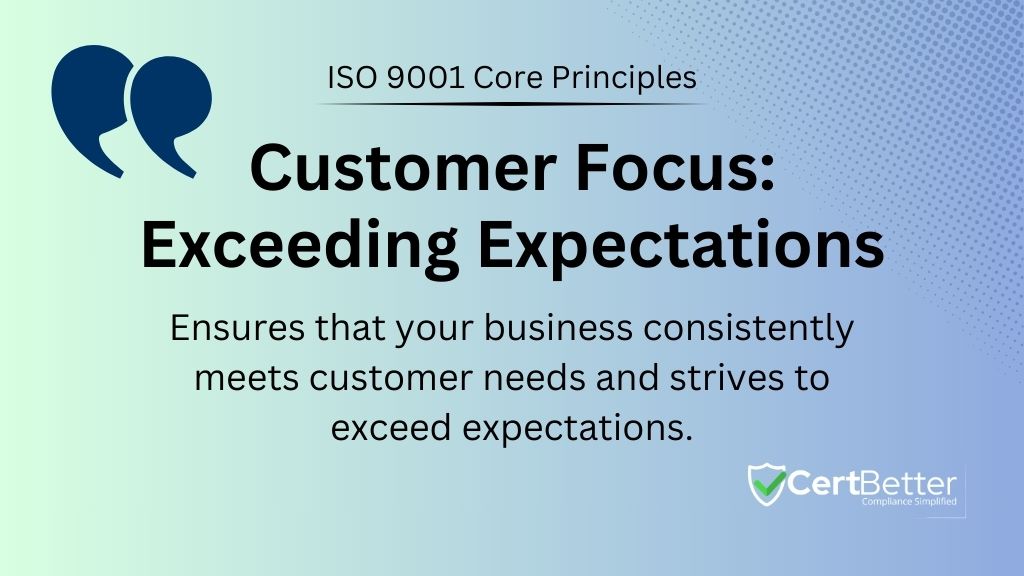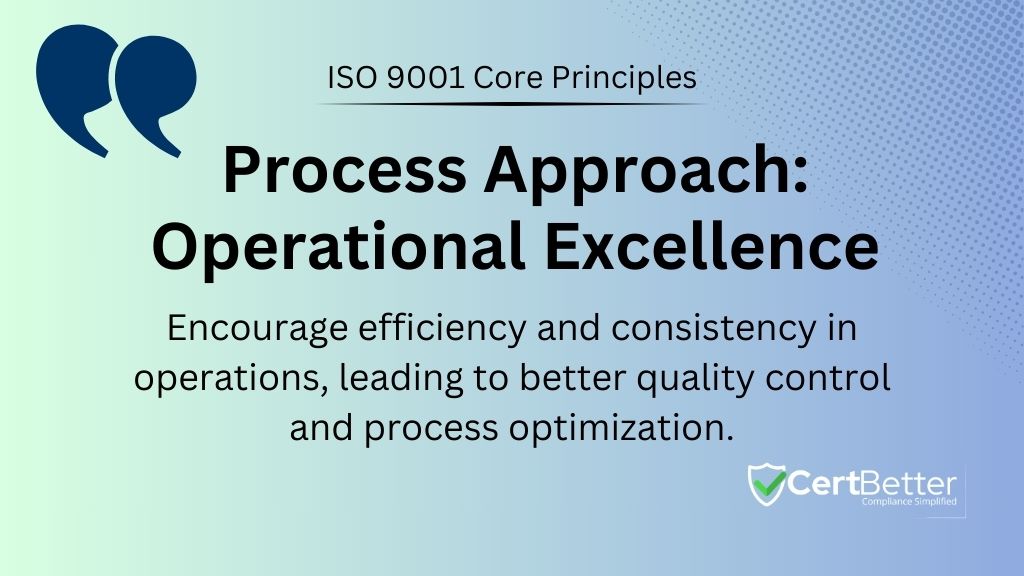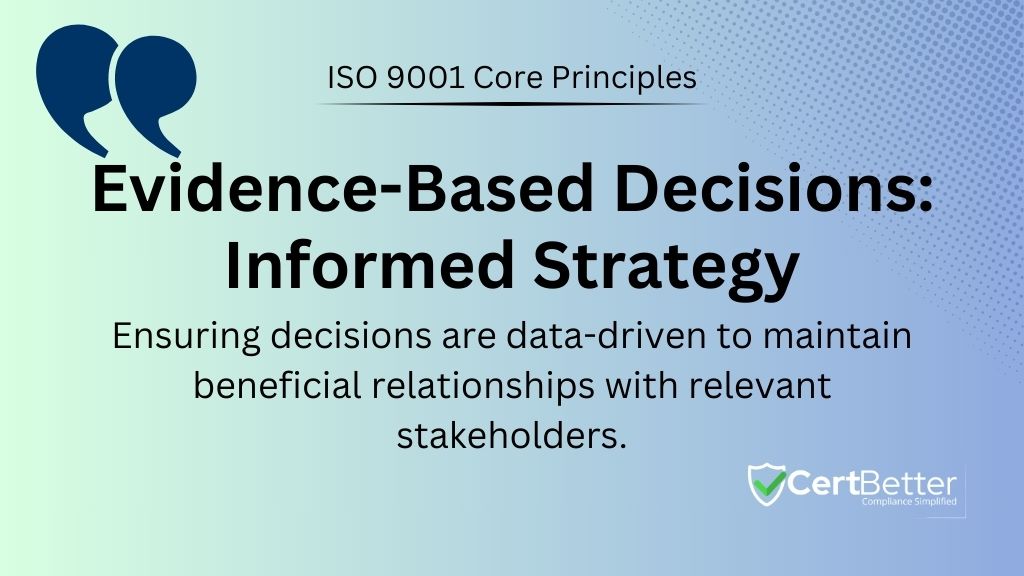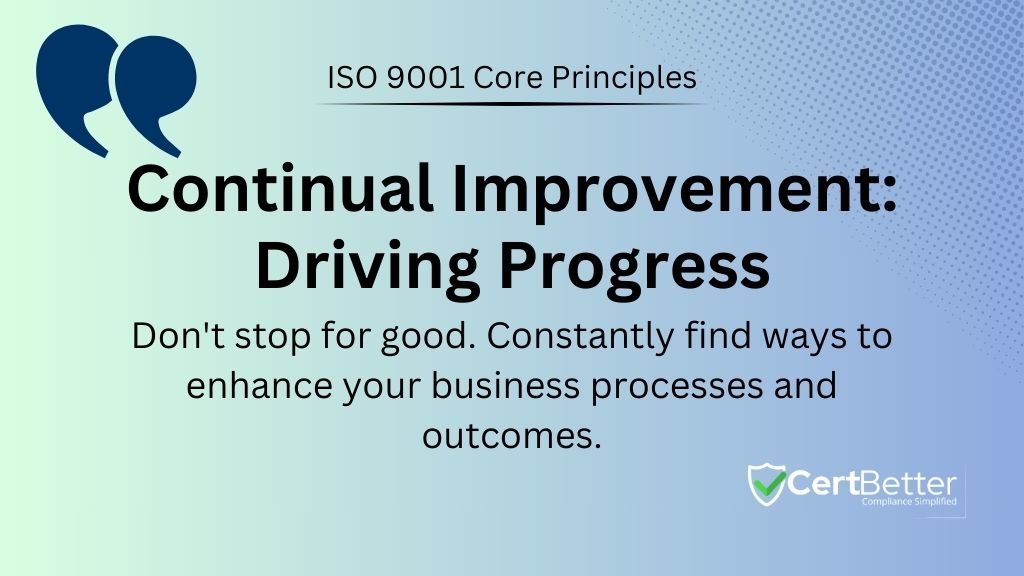8 Steps To Align Your Business With ISO 9001 Core Principles

The ISO 9001 standard is not just a set of guidelines; it’s a comprehensive framework for quality management that ensures your business consistently delivers products or services that meet customer and regulatory requirements. Aligning your business strategy with ISO 9001 standard can be a challenging step if you’re a business manager or owner. Let’s take a deep dive into the best practices to align your business stretegy around ISO Quality Standard.
Why Align your Business with ISO 9001?
For Australian and overseas businesses, integrating ISO 9001 principles as part of their ISO certification is more than a compliance exercise. It’s more like a strategic move towards operational excellence, enhanced customer satisfaction and sustainable business growth.
This strategic alignment ensures that your organization’s direction is not only in harmony with quality management principles but also sets a foundation for continual improvement and customer-centric approaches, essential in today’s dynamic business environment.
No matter where your company is located, you can use these core quality principles to improve your company’s performance, gain credibility and become more competitive in your industry.
Let’s look at the very first step..
Understanding ISO 9001 Core Principles
ISO 9001 is built on seven key principles that form the bedrock of effective quality management. I have added an additional core principle which is indirectly expected of businesses and is often misunderstood when I run my audits.
1. Customer Focus — ensures that your business consistently meets customer needs and strives to exceed expectations.
2. Leadership involvement — foster a purpose-driven culture and align the organisation’s strategies with its quality objectives.
3. Risk-based Thinking — Incorporating risk management into your strategy to set priorities important for your stakeholders.
4. Process approach — encourages efficiency and consistency in operations, leading to better quality control and process optimization.
5. Stakeholders Invovement — ensuring staff members and other stakeholders such as suppliers and contractors are involved and aware of the business priorities.
6. Evidence-based Decisions — ensuring decisions are data-driven to maintain beneficial relationships with relevant stakeholders.
7. Continual improvement — Constantly find ways to enhance your business processes and outcomes.
8. Measuring Success — use various paramters such as KPIs and targets to measure your business performance.
Let’s take a closer look to understand how they apply to different industries.
Customer Focus: Exceeding Expectations

In any industry, understanding and meeting customer needs is pretty much a basic principle. However, ISO 9001 talks about aligning your business strategy to focus on customer needs so you’re not only meeting their needs but exceeding their expectations.
In the retail sector, this might involve analyzing purchasing trends and customer feedback to tailor product offerings.
In the services sector, such as hospitality, it’s about creating memorable customer experiences through personalized service and attention to detail.
In manufacturing, customer focus translates to delivering products that meet specific standards and requirements.
In the healthcare industry, it means providing patient-centered care that prioritizes patient safety and satisfaction.
As you can see across all sectors, customer focus is all about building trust and loyalty by consistently delivering value and excellence so they keep coming back to your business.
Leadership Involvement: Steering Success

Effective leadership is crucial in embedding a quality-centric culture across various industries.
Why does ISO talk about leadership involvement? Because business leaders are responsible for setting the direction and providing resources to comfortably drive on that path.
In the technology sector, this could involve leaders driving innovation while ensuring adherence to quality standards in product development.
In construction, leadership involvement might mean emphasizing safety and quality in every project phase, from planning to execution.
In the financial services, leadership is key in ensuring compliance with regulations and ethical standards while also driving customer satisfaction through reliable and transparent services.
In education, leaders play a vital role in shaping academic excellence and ensuring the institution meets the evolving needs of students and the community.
As you already observed, in every industry, leadership involvement is about setting the vision, providing direction and helping teams achieve excellence in quality and service.
Risk-Based Thinking: Navigating Uncertainty

Risk-based thinking is integral to strategic planning, allowing businesses to proactively manage potential challenges and capitalize on opportunities.
This approach is not only ISO 9001 principle but rather a universal principle that can be applied across various sectors with significant benefits.
In the financial sector, risk-based thinking involves assessing market volatility, regulatory compliance risks, and credit risks. Financial institutions use this approach to tailor their investment strategies, develop risk mitigation plans, and ensure robust financial health.
In manufacturing, risk management might focus on supply chain disruptions, quality control issues, or machinery breakdowns. By identifying these risks early, manufacturers can develop contingency plans, maintain quality standards, and ensure uninterrupted production.
The technology industry faces risks related to rapid innovation, data security, and intellectual property protection. Risk-based strategic planning in this sector often involves staying ahead of technological trends, investing in cybersecurity, and protecting intellectual assets.
For businesses in the healthcare sector, patient safety, data privacy, and regulatory compliance are paramount risks. Healthcare providers utilize risk-based thinking to enhance patient care protocols, safeguard patient data, and adhere to healthcare regulations.
In the retail industry, risks can include consumer preference shifts, supply chain inefficiencies, and e-commerce competition. Retailers employing risk-based strategies focus on market research, supply chain optimization, and digital transformation to stay competitive and meet consumer demands.
Process Approach: Operational Excellence

Adopting a process approach means structuring operations around clearly defined and efficiently managed processes. This approach is one of the key principles in ISO 9001 and is crucial for operational excellence across various industries, as it helps in achieving consistency, efficiency and quality in products and services.
For a cleaning service provider, a process approach might involve standardized cleaning protocols to ensure consistent service quality. This could include checklists for different types of spaces (offices, homes, industrial areas).
In the import-export sector, a process-driven approach is vital for managing complex logistics. This includes processes for regulatory compliance, customs clearance, inventory management, and quality control checks.
For a company offering recreational services, operational excellence might involve process optimization for booking and reservation systems, maintenance of equipment and facilities, and customer feedback collection to enhance the guest experience.
A tool manufacturing company benefits significantly from a process approach in its production operations. This could involve processes for raw material procurement, quality control at different stages of production, and final product testing.
For a restaurant, it could be about ensuring food safety and quality through standardized cooking and hygiene processes.
In healthcare, it might involve patient care protocols to ensure consistent and high-quality patient experiences.
In education, a process-driven approach could be used to develop and deliver curriculum, ensuring a high standard of education and learning outcomes.
Stakeholder Assurance: Better Management

Stakeholder assurance is about ensuring that all parties involved in a business – from employees to suppliers and contractors – are competent in their roles, managed effectively and aware of the company’s processes and objectives.
This core principle of ISO 9001 is vital across different industries, as it directly impacts the quality of products and services and the overall success of the business.
In software developement sector, ensuring that developers and project managers are well-versed in the latest programming languages, development methodologies, and client requirements is crucial.
In Healthcare Facility, stakeholder assurance means that all healthcare professionals, including doctors, nurses, and support staff, are not only qualified but also continually updated on the latest medical practices and health care regulations.
In construction, it’s essential that contractors, engineers, and workers are skilled and knowledgeable about current building codes, safety regulations, and environmentally sustainable practices.
For schools and universities, stakeholder assurance involves ensuring that educators are not only experts in their respective fields but also adept in contemporary teaching methodologies.
In Hospitality sector, stakeholder assurance translates into training staff in customer service, hygiene standards, and operational procedures. For instance, ensuring that chefs are proficient in food safety and culinary skills, while front desk staff are trained in customer interaction and reservation systems, contributes to a high-quality guest experience.
For a retail company, stakeholder assurance might involve training sales staff on product knowledge, customer service, and inventory management. It also means ensuring that suppliers understand and adhere to quality standards and delivery timelines.
Evidence-Based Decisions: Informed Strategy

The principle of evidence-based decision-making as a core ISO 9001 principle involves using data, facts, and insights to guide business strategies and actions. This approach ensures that decisions are grounded in reality rather than intuition or assumption.
For businesses in agriculture, evidence-based decisions might involve analyzing soil and weather data to determine the best planting times and crops to grow. Additionally, data on pest patterns and crop yields can inform decisions about pest control and harvesting schedules.
In the financial sector, evidence-based decisions are critical for risk assessment and investment strategies. This could involve analyzing market trends, economic indicators, and client portfolios to make informed investment decisions and provide sound financial advice to clients.
For healthcare providers, evidence-based decision-making is pivotal in treatment plans and healthcare policies. This involves using clinical data, research findings, and patient history to make decisions about patient care and treatment methodologies.
Retailers rely on customer data, market trends, and sales analytics to make decisions about inventory management, marketing strategies, and customer engagement. For instance, analyzing purchasing patterns can help a retailer decide which products to stock more of and which to discontinue.
In the tech industry, decisions on product development, user experience design, and market entry strategies are often driven by data such as user feedback, market research, and technology trends. This ensures that products meet market needs and stay ahead of competition.
For companies in Transportation and Logistics sector, evidence-based decisions might include route optimization based on traffic data, fleet management based on vehicle performance data, and logistics planning based on supply and demand patterns.
Continual Improvement: Driving Progress

The principle of continual improvement in ISO 9001 is a cornerstone of success in any industry, focusing on making ongoing, incremental enhancements to processes, products, and services. It’s about not being complacent, but always looking for ways to do better. Here’s how this principle is applied in some less common industries:
In the renewable energy sector, continual improvement might involve innovating more efficient solar panels, developing better wind turbine designs, or enhancing battery storage technology. For instance, a company could be continually testing new materials to increase the energy output of solar panels while reducing manufacturing costs.
For organizations in the space sector, continual improvement is about enhancing spacecraft design for safety and efficiency, improving satellite communication technology, and developing more sustainable and cost-effective launch methods. An example could be refining propulsion systems to make space travel more accessible and environmentally friendly.
In aquaculture sector, continual improvement could involve developing more sustainable fish farming practices, improving feed efficiency, and implementing advanced monitoring systems to better manage aquatic environments. This might include using IoT sensors to optimize water quality and fish health.
For businesses in waste management and recycling, continual improvement focuses on developing more efficient recycling processes, finding new ways to repurpose waste materials, and enhancing waste collection and sorting technologies. An innovative example could be the development of a new process to recycle a previously non-recyclable material.
Companies in Virtual and Augmented Reality sector might focus on continually improving the user experience, developing more realistic virtual environments, and finding new applications for VR/AR technology, such as in education, training, or therapy.
In urban farming, continual improvement could involve experimenting with new hydroponic or aquaponic systems, optimizing space usage in vertical farms, or integrating smart technology to better control growing conditions.
Measuring Success: Performance Evaluation

Another core principle of ISO 9001 is measuring success that can be applied to various industries, each with its unique set of metrics and Key Performance Indicators (KPIs).
For a telecom company, key metrics for measuring success might include network uptime, customer churn rate, average revenue per user (ARPU), and customer satisfaction scores. Network uptime is critical in assessing the reliability of services, while customer churn rate helps in understanding customer retention effectiveness.
Maintenance service providers often measure success through contract fulfillment rates, response times to service calls, customer satisfaction levels, and safety compliance metrics. Contract fulfillment rates indicate how effectively the company meets its service agreements, response times are a measure of efficiency and reliability, customer satisfaction scores provide feedback on service quality.
For businesses dealing with importation, success measurement might focus on metrics such as on-time delivery rates, compliance with quality standards, inventory turnover rates, and cost-effectiveness. On-time delivery rates are crucial for supply chain efficiency, quality compliance ensures product reliability, inventory turnover rates indicate how well the inventory is managed.
A warehousing company would measure success through metrics such as inventory accuracy, order fulfillment accuracy, storage utilization rates, and operational costs. Inventory accuracy is vital for tracking stock levels, order fulfillment accuracy impacts customer satisfaction, storage utilization rates determine the efficiency of space usage.
Final Thoughts
I hope this has given you a solid understanding of aligning your strategy with ISO 9001 core principles. Begin with a strong foundation: leadership commitment and a focus on customer needs are crucial. Then, integrate risk-based thinking for proactive solutions and a process-driven approach for consistent operational quality. Effective stakeholder management, coupled with precise metrics and evidence-based decisions, will guide your path. Lastly, prioritize continual improvement to adapt to the ever-changing business landscape, ensuring ongoing success and quality enhancement.
- Last updated: May 22, 2024
- CertBetter
Our community of compliance professionals and ISO experts is ready to provide you with insightful answers and practical solutions. Join the discussion now!
- Recommended Reads
- 33 reads
-
Frequently Asked Questions
Understanding ISO Terminology: Guide to Important Terms and Concepts
No posts found
ResetConnect with ISO Certification Consultants
CertBetter makes it easy to find ISO certification consultants and compliance professionals from around the globe.

